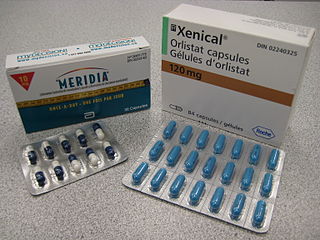Related Research Articles

Anti-obesity medication or weight loss medications are pharmacological agents that reduce or control excess body fat. These medications alter one of the fundamental processes of the human body, weight regulation, by reducing appetite and consequently energy intake, increasing energy expenditure, redirecting nutrients from adipose to lean tissue, or interfering with the absorption of calories.
Enteroglucagon is a peptide hormone derived from preproglucagon. It is a gastrointestinal hormone, secreted from mucosal cells primarily of the colon and terminal ileum. It consists of 37 amino acids. Enteroglucagon is released when fats and glucose are present in the small intestine; which decrease the motility to allow sufficient time for these nutrients to be absorbed.

Exenatide, sold under the brand name Byetta and Bydureon among others, is a medication used to treat diabetes mellitus type 2. It is used together with diet, exercise, and potentially other antidiabetic medication. It is a treatment option after metformin and sulfonylureas. It is given by injection under the skin twice daily or once weekly.

Glucagon-like peptide-1 (GLP-1) is a 30- or 31-amino-acid-long peptide hormone deriving from the tissue-specific posttranslational processing of the proglucagon peptide. It is produced and secreted by intestinal enteroendocrine L-cells and certain neurons within the nucleus of the solitary tract in the brainstem upon food consumption. The initial product GLP-1 (1–37) is susceptible to amidation and proteolytic cleavage, which gives rise to the two truncated and equipotent biologically active forms, GLP-1 (7–36) amide and GLP-1 (7–37). Active GLP-1 protein secondary structure includes two α-helices from amino acid position 13–20 and 24–35 separated by a linker region.

The glucagon-like peptide-1 receptor (GLP1R) is a G protein-coupled receptor (GPCR) found on beta cells of the pancreas and on neurons of the brain. It is involved in the control of blood sugar level by enhancing insulin secretion. In humans it is synthesised by the gene GLP1R, which is present on chromosome 6. It is a member of the glucagon receptor family of GPCRs. GLP1R is composed of two domains, one extracellular (ECD) that binds the C-terminal helix of GLP-1, and one transmembrane (TMD) domain that binds the N-terminal region of GLP-1. In the TMD domain there is a fulcrum of polar residues that regulates the biased signaling of the receptor while the transmembrane helical boundaries and extracellular surface are a trigger for biased agonism.

G protein-coupled receptor 119 also known as GPR119 is a G protein-coupled receptor that in humans is encoded by the GPR119 gene.

Liraglutide, sold under the brand names Victoza and Saxenda among others, is an anti-diabetic medication used to treat type 2 diabetes, and chronic obesity. It is a second-line therapy for diabetes following first-line therapy with metformin. Its effects on long-term health outcomes like heart disease and life expectancy are unclear. It is given by injection under the skin.
Albiglutide is a glucagon-like peptide-1 agonist drug marketed by GlaxoSmithKline (GSK) for treatment of type 2 diabetes. As of 2017 it is unclear if it affects a person's risk of death. GSK has announced that it intends to withdraw the drug from the worldwide market by July 2018 for economic reasons.
Glucagon-like peptide-1 (GLP-1) receptor agonists, also known as GLP-1 analogs, are a class of drugs that reduce blood sugar and energy intake by activating the GLP-1 receptor. They mimic the actions of the endogenous incretin hormone GLP-1 that is released by the gut after eating.

Dulaglutide, sold under the brand name Trulicity among others, is a medication used for the treatment of type 2 diabetes in combination with diet and exercise. It is also approved in the United States for the reduction of major adverse cardiovascular events in adults with type 2 diabetes who have established cardiovascular disease or multiple cardiovascular risk factors. It is a once-weekly injection.

Setmelanotide, sold under the brand name Imcivree, is a medication used for the treatment of genetic obesity caused by a rare single-gene mutation.
Semaglutide is an antidiabetic medication used for the treatment of type 2 diabetes and an anti-obesity medication used for long-term weight management. It was developed by Novo Nordisk It was approved for use in the US in 2017. It is a peptide similar to the hormone glucagon-like peptide-1 (GLP-1), modified with a side chain. It can be administered by subcutaneous injection or taken orally. It is sold under the brand names Ozempic (injectable) and Rybelsus (pill) for diabetes, and under the brand name Wegovy for weight loss.
Dasiglucagon, sold under the brand name Zegalogue, is a medication used to treat severe hypoglycemia in people with diabetes.

Tirzepatide, sold under the brand name Mounjaro among others, is an antidiabetic medication used for the treatment of type 2 diabetes and for weight loss. Tirzepatide is administered through subcutaneous injection.

Orforglipron (LY-3502970) is a non-peptide glucagon-like peptide-1 receptor agonist developed as a weight loss drug by Eli Lilly and Company. It is easier to produce than GLP-1 agonists on the market in 2023 and is expected to be cheaper.
Retatrutide (LY-3437943) is an experimental drug for obesity developed by American pharmaceutical company Eli Lilly and Company. It is a triple hormone receptor agonist of GLP-1, GIP, and GCGR receptors. It has been shown to achieve a more than 24% mean weight reduction in adults without diabetes but with obesity or preobesity (overweight) during a phase 2 trial. The drug is a peptide with amino acid sequence YA1QGTFTSDYSIL2LDKK4AQA1AFIEYLLEGGPSSGAPPPS3.
NNC9204-1706 or NN9423 is a GLP-1/GIP/glucagon receptor triple agonist developed by Novo Nordisk. It was evaluated in a clinical trial; adverse effects such as "dose-dependent increases in heart rate and reductions in reticulocyte count, increases in markers of inflammation and hepatic disturbances, and impaired glucose tolerance at the highest dosages" meant that the drug was declared to have an inadequate safety profile and discontinued.
Mazdutide is a dual agonist of the GLP-1 receptor and glucagon receptor. It is an analog of oxyntomodulin (OXM). The drug is developed by Eli Lilly and is currently in a Phase II study.
Glucagon receptor agonists are a class of drugs under development for the treatment of obesity, non-alcoholic fatty liver disease, and congenital hyperinsulinism.
GLP1 poly-agonist peptides are a class of drugs that activate multiple peptide hormone receptors including the glucagon-like peptide-1 (GLP-1) receptor. These drugs are developed for the same indications as GLP-1 receptor agonists—especially obesity, type 2 diabetes, and non-alcoholic fatty liver disease. They are expected to provide superior efficacy with fewer adverse effects compared to GLP-1 mono-agonists, which are dose-limited by gastrointestinal disturbances. The effectiveness of multi-receptor agonists could possibly equal or exceed that of bariatric surgery. The first such drug to receive approval is tirzepatide, a dual agonist of GLP-1 and GIP receptors.
References
- ↑ Parker VE, Robertson D, Wang T, Hornigold DC, Petrone M, Cooper AT, et al. (March 2020). "Efficacy, Safety, and Mechanistic Insights of Cotadutide, a Dual Receptor Glucagon-Like Peptide-1 and Glucagon Agonist". The Journal of Clinical Endocrinology and Metabolism. 105 (3): 803–820. doi: 10.1210/clinem/dgz047 . PMID 31608926. S2CID 204546248.
- ↑ Henderson SJ, Konkar A, Hornigold DC, Trevaskis JL, Jackson R, Fritsch Fredin M, et al. (December 2016). "Robust anti-obesity and metabolic effects of a dual GLP-1/glucagon receptor peptide agonist in rodents and non-human primates". Diabetes, Obesity & Metabolism. 18 (12): 1176–1190. doi:10.1111/dom.12735. PMC 5129521 . PMID 27377054.
- ↑ "Cotadutide". ClinicalTrials.gov. Retrieved 2021-02-18.